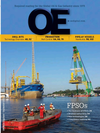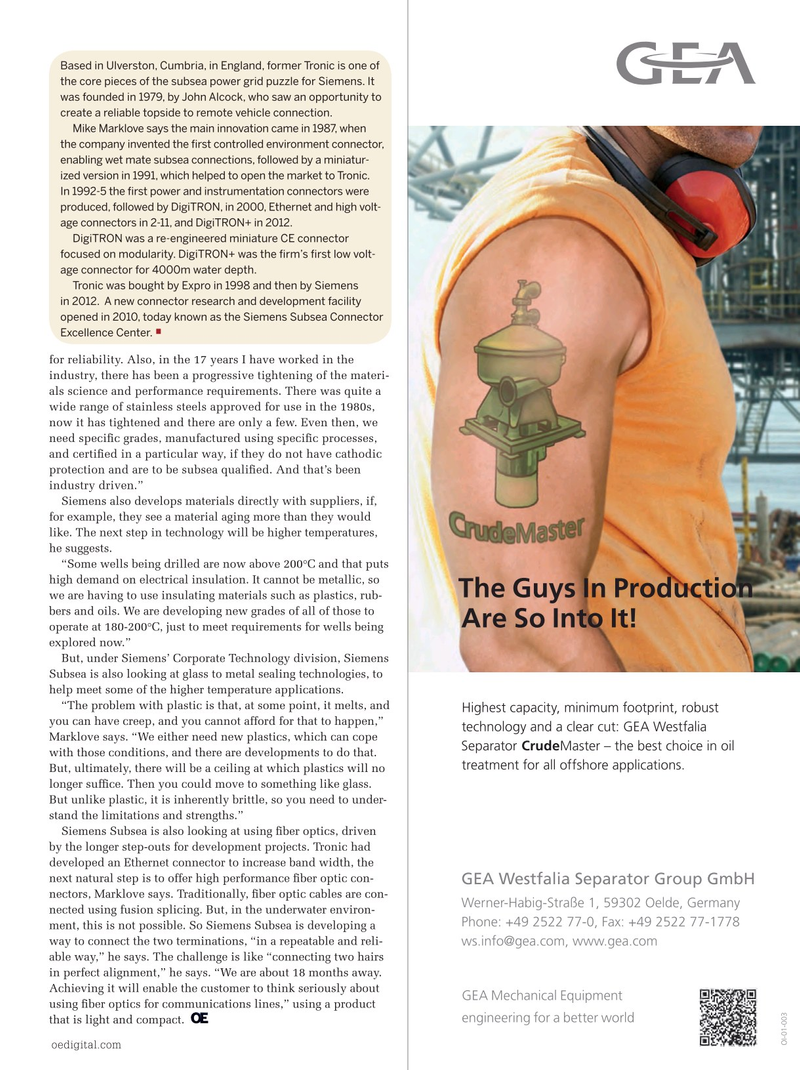
Page 79: of Offshore Engineer Magazine (Sep/Oct 2014)
Read this page in Pdf, Flash or Html5 edition of Sep/Oct 2014 Offshore Engineer Magazine
Based in Ulverston, Cumbria, in England, former Tronic is one of the core pieces of the subsea power grid puzzle for Siemens. It was founded in 1979, by John Alcock, who saw an opportunity to create a reliable topside to remote vehicle connection.
Mike Marklove says the main innovation came in 1987, when the company invented the frst controlled environment connector, enabling wet mate subsea connections, followed by a miniatur- ized version in 1991, which helped to open the market to Tronic.
In 1992-5 the frst power and instrumentation connectors were produced, followed by DigiTRON, in 2000, Ethernet and high volt- age connectors in 2-11, and DigiTRON+ in 2012.
DigiTRON was a re-engineered miniature CE connector
Higher Availability with focused on modularity. DigiTRON+ was the frm’s frst low volt- age connector for 4000m water depth.
Full Budget Control
Tronic was bought by Expro in 1998 and then by Siemens in 2012. A new connector research and development facility opened in 2010, today known as the Siemens Subsea Connector
Excellence Center. • for reliability. Also, in the 17 years I have worked in the industry, there has been a progressive tightening of the materi- als science and performance requirements. There was quite a wide range of stainless steels approved for use in the 1980s, now it has tightened and there are only a few. Even then, we need specifc grades, manufactured using specifc processes, and certifed in a particular way, if they do not have cathodic protection and are to be subsea qualifed. And that’s been industry driven.”
Siemens also develops materials directly with suppliers, if, for example, they see a material aging more than they would like. The next step in technology will be higher temperatures, he suggests. “Some wells being drilled are now above 200°C and that puts high demand on electrical insulation. It cannot be metallic, so
The Guys In Production we are having to use insulating materials such as plastics, rub- bers and oils. We are developing new grades of all of those to
Are So Into It! operate at 180-200°C, just to meet requirements for wells being explored now.”
But, under Siemens’ Corporate Technology division, Siemens
Subsea is also looking at glass to metal sealing technologies, to help meet some of the higher temperature applications. “The problem with plastic is that, at some point, it melts, and
Highest capacity, minimum footprint, robust you can have creep, and you cannot afford for that to happen,” technology and a clear cut: GEA Westfalia
Marklove says. “We either need new plastics, which can cope
Separator CrudeMaster – the best choice in oil with those conditions, and there are developments to do that. treatment for all offshore applications.
But, ultimately, there will be a ceiling at which plastics will no longer suffce. Then you could move to something like glass.
But unlike plastic, it is inherently brittle, so you need to under- stand the limitations and strengths.”
Siemens Subsea is also looking at using fber optics, driven by the longer step-outs for development projects. Tronic had developed an Ethernet connector to increase band width, the next natural step is to offer high performance fber optic con-
GEA Westfalia Separator Group GmbH nectors, Marklove says. Traditionally, fber optic cables are con-
Werner-Habig-Straße 1, 59302 Oelde, Germany nected using fusion splicing. But, in the underwater environ-
Phone: +49 2522 77-0, Fax: +49 2522 77-1778 ment, this is not possible. So Siemens Subsea is developing a way to connect the two terminations, “in a repeatable and reli- [email protected], www.gea.com able way,” he says. The challenge is like “connecting two hairs in perfect alignment,” he says. “We are about 18 months away.
Achieving it will enable the customer to think seriously about
GEA Mechanical Equipment using fber optics for communications lines,” using a product engineering for a better world that is light and compact.
OI-01-003 oedigital.com 078_0914_subsea3_siemens.indd 81 8/21/14 6:46 PM

 78
78

 80
80